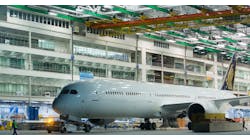Curtiss-Wright Corporation’s Surface Technologies segment announced it has a contract from Rolls-Royce to establish and operate a laser-peening production cell within that company’s wide chord fan blade (WCFB) manufacturing plant in Singapore. In fact, the laser-peening cell is already fully operational and processing fan blades for certain Trent aero engines. The terms of the contract were not revealed.
Rolls-Royce Group plc is one of the world’s largest manufacturers of aircraft engines for civil and military jets, and the various versions of its Trent high-bypass turbofan engines are installed in numerous commercial aircraft, including Airbus A330, A340, A380, and the forthcoming Airbus AXWB models, and Boeing 777 and 787 Dreamliners.
A wide chord fan (or high bypass) is a turbofan engine developed originally by Rolls-Royce, involving a “ducted fan” with wider blades than comparable jet engine designs.
Rolls opened its first Asian aero engine plant in Singapore last year. It is the group’s first plant manufacturing wide chord fan blades outside the U.K., producing the parts for multiple Trend aero engine models. At full capacity, it will produce more than 6,000 blades annually.
Curtiss-Wright develops engineered processes and products focused on flow control, motion control, and surface treatment. The company’s laser-peening technology is based on a Neodymium glass-laser technology, developed by Curtiss-Wright together with the Lawrence Livermore National Laboratory.
In the process, a laser beam with a peak power output of 1,000 MW is pulsed and directed at the surface of metal parts: Pressure waves of 1 million lb/sq.in. are generated at the surface that compress the metal and leave a protective, residual compressive stress layer beneath the surface. “This compressive stress acts to increase the component's resistance to failure mechanisms such as fatigue, fretting fatigue, and stress-corrosion cracking,” according to Curtiss-Wright, “which in turn translates into increased component life and reduced maintenance costs.”
Curtiss-Wright Surface Technologies operates laser-peening facilities in Livermore and Palmdale, Calif.; Frederickson, Wash., and Earby, England. It also has mobile laser-peening systems.
"We are very pleased to be providing Rolls-Royce with our state-of-the-art laser-peening technology for their most advanced commercial engine designs," stated Martin R. Benante, Curtiss-Wright chairman and CEO. "This award is a significant milestone in continuing to expand our proprietary laser-peening technology globally. A number of industry leaders, such as Boeing and Siemens, have also recognized the benefits of this unique and highly technical offering."






